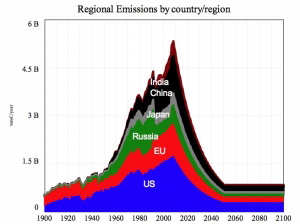 By Scott Badenoc
By Scott Badenoc
Why it matters:
Policymakers are not scientists and have never been able to see the impact of their policy decisions on climate change, until now.
Recap:
ClimateInteractive.org is the web-based version of one of the most important pieces of software in human history known as C-ROADS. Climate Interactive is a tool "to improve the way leaders and citizens around the world think about the climate" by allowing them to see the impacts of changing governmental policy via simulations "that provide immediate feedback, so users can see the results of different scenarios on atmospheric carbon levels and temperature."
They go on to describe the real purpose of the tool:
C-ROADS is being used within international climate negotiations. The United States Department of State has used the C-ROADS simulator to understand the climate impacts of various country-level proposals and to share that understanding with other parties to the UNFCCC (for example, Deputy Special Envoy Jonathan Pershing presented C-ROADS analysis at the April '09 UNFCCC meeting in Bonn).
Don't simulations like this already exist? Not really. Most existing energy and climate models are extremely complex, take days to run, and can't be used by untrained people.
We're working to change that.
Could this be the vital bridge to Copenhagen where policy makers can finally best the difficult learning curve with an easy-to-use software tool, leading to international consensus on how to stabilize climate change?
Commentary:
So much of the what we read in the media from major outlets is based on a couple isolated facts and a great deal of opinion, non-scientific opinion at that. Will 50% reductions world wide by 2050 be enough to halt non-linear climate change? What about 80% by 2020? Well, until now, we'd never really know until we saw it work…or not, at which point it would be too late.
Climate Interactive empowers the public at large, but more particularly, international policy makers to go to Copenhagen with a concrete understanding of the ramifications of their collective actions. The tool also helps them do something they're not used to doing: thinking in cycles. Ecosystems are not linear, they are…ahem, systems. When CO2 is released, temperature rises which causes ice to melt which releases CO2 which causes temperature rises which causes ice to melt which releases CO2 and so on….
Currently the US State Department is using the tool very actively to determine what the best course of action is for them and the rest of the world. China, the EU and several other key countries are apparently spending serious time with this tool to play out all the scenarios in advance of the big game: Copenhagen.
Four Creative Citizens (me, Argam DerHartunian, Sarah Backhouse and Tim Donovan), were invited to a private presentation at CAA in Los Angeles to see Dr. John Sterman, head of MIT's System Dynamics Group, walk us through the reasoning behind the C-ROADS tool and the power of the simulator. One of the major revelations for all of us: just how stark the results would be for our planet if we take a path they call BAU or Business As Usual. In other words, without serious international action beginning immediately, life as we know it on this planet is going to take an incredibly unpredictable and dangerous path.
The reality is that the current proposals given by the vaunted nations of our globe would not amount to the change we need, in fact far from it. Dr. Sterman made the very clear case that the US et al must take their proposed policy changes to the next level…or else.
Despite the stark nature of the presentation, Sterman says there is much to be hopeful for. He declares (as we here at Creative Citizen have many times) that this is the "greatest business opportunity of all time" and "to never underestimate the power of human ingenuity."
He went on to correct what he considers to be a common "false mental model" in the minds of our leadership, the concept of a modern Manhattan Project, where the world's greatest scientists converge in the name of security to take a massive leap forward in technology. Why won't it work that way this time? The green economy must be done in public; where the Manhattan Project was totally clandestine, this must be a public movement.
Dr. Sterman went on to discuss the current evolutionary trend away from the idea and term of a "green" or "sustainable" economy to a "restorative" or "regenerative" economy, where we don't save 20, 50, 80% on emissions, we go carbon negative. Imagine cars that clean the air, yards that sequester carbon, factories that leave every element they come in contact with better off than before.
This is the future. Climate Interactive and the guys at MIT are working with the world to ensure we have one. If the policymakers get comfortable with this tool in time, the world may see a miracle in Copenhagen.
Creative Solutions: